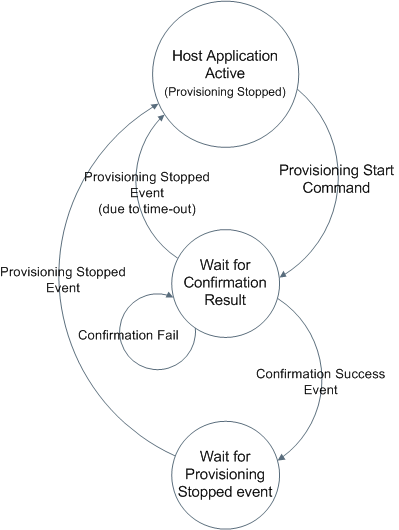SWRU455M February 2017 – October 2020 CC3120 , CC3120MOD , CC3130 , CC3135 , CC3135MOD , CC3220MOD , CC3220MODA , CC3220R , CC3220S , CC3220SF , CC3230S , CC3230SF , CC3235MODAS , CC3235MODASF , CC3235MODS , CC3235MODSF , CC3235S , CC3235SF
- 1 Overview
- 1 Introduction
- 2 Networking Application
- 3 Device
-
4 WLAN
- 4.1 Introduction
- 4.2 Key Features
- 4.3 Station (STA)
- 4.4 Access Point
- 4.5 Wi-Fi Direct
- 4.6 WLAN Security
- 4.7 Scan
- 4.8 Antenna Diversity
- 4.9 Calibrations
- 4.10 BLE / 2.4-GHz Radio Coexistence
- 5 Network Addresses
- 6 Socket
-
7 Secure Socket
- 7.1 Introduction
- 7.2 Key Features
- 7.3 Opening a Secure Socket
- 7.4 Trusted Root-Certificate Catalog
- 7.5
Options and Features Use
- 7.5.1 Set TLS Version
- 7.5.2 Set Cipher Suites
- 7.5.3 Set Certificates, Root CA, Private Key, and DH Files
- 7.5.4 Disable the Use of the Trusted Root-Certificate Catalog
- 7.5.5 Set ALPN List
- 7.5.6 Set Domain Name for Verification and SNI
- 7.5.7 Enable OCSP Check
- 7.5.8 Upgrade Nonsecured Socket to Secured
- 7.5.9 Get Connection Parameters
- 7.6 Supported Cryptographic Algorithms
- 7.7 Common Errors and Asynchronous Events
-
8 File System
- 8.1 Introduction
- 8.2 Key Features
- 8.3 File System Characteristics
- 8.4 Write a File
- 8.5 Read a File
- 8.6 Delete a File
- 8.7 Rename a File
- 8.8 File System Helper Functions
- 8.9 Bundle Protection
- 8.10 File Commit Feature
- 8.11 File Rollback Process
- 8.12 Programming
- 8.13 Restore to Factory
- 8.14 Security Alerts
- 8.15 Design Consideration
- 9 HTTP Server
- 10mDNS
- 11Rx Filters
- 12Ping
- 13Transceiver
- 14Real-Time RSSI
- 15Power Management
-
16Provisioning
- 16.1 Introduction
- 16.2 Key Features
- 16.3 Provisioning Process Overview
- 16.4 Host Provisioning Application Flow
- 16.5 Configuration Modes
- 16.6 Starting and Stopping the Provisioning Process
- 16.7 Auto-Provisioning
- 16.8 Delivering Feedback to the User
- 16.9 External Configuration
- 16.10 Common Events and Errors
- 16.11
Usage Examples
- 16.11.1 Successful SmartConfig Provisioning
- 16.11.2 Unsuccessful SmartConfig Provisioning
- 16.11.3 Successful SmartConfig Provisioning With AP Fallback
- 16.11.4 Successful AP Provisioning
- 16.11.5 Successful AP Provisioning With Cloud Confirmation
- 16.11.6 Using External Configuration Method: WAC
- 16.11.7 Successful SmartConfig Provisioning While External Configuration Enabled
- 17Crypto Utilities
- 18Hostless Mode
-
19Porting the Host Driver
- 19.1 Introduction
- 19.2 Create Platform Porting File
- 19.3 Select Capabilities Set
- 19.4 Bind the Device Enable/Disable Line
- 19.5 Implement the Interface Communication Abstract Layer
- 19.6 Choose Memory-Management Model
- 19.7 Implement OS Adaptation Layer
- 19.8 Implement Timestamp Services
- 19.9 Set Asynchronous Event Handler Routines
-
20Debug
- 20.1
Capture NWP Logs
- 20.1.1 Overview
- 20.1.2
Instructions
- 20.1.2.1 Configuring Pin Mux for CC32xx
- 20.1.2.2 Terminal Settings
- 20.1.2.3 Run Your Program
- 20.1.2.4
Send to TI Engineer
-
A Host APIs
-
A.1 Host APIs
-
B Persistency
-
B.1 Persistency
-
C Regulatory
Domain
-
C.1 Regulatory Domain
-
D Supported Host
Interfaces
- D.1 SPI Host Interface
- D.2 UART Host Interface
-
D Supported Host
Interfaces
-
C.1 Regulatory Domain
-
C Regulatory
Domain
-
B.1 Persistency
-
B Persistency
-
A.1 Host APIs
-
A Host APIs
- 20.1
Capture NWP Logs
16.4 Host Provisioning Application Flow
The entire provisioning process (adding profiles, confirming profiles, and delivering confirmation results to the user) is executed internally by the networking subsystem. The host application is responsible only for initiating the process. Once the process is started, no further actions are needed.
Figure 17-2 depicts the host application during a provisioning process.
After a provisioning process is started, the host should wait for the networking subsystem to send it the profile confirmation result. During this time, the host application should not perform any networking activity that may interrupt the ongoing provisioning process. The confirmation result is sent after the end-user has configured a profile and the networking subsystem has finished confirming it.
Possible confirmation result values:
- Confirmation failed, SSID was not found during scan
- Confirmation failed, SSID was found, but WLAN connection failed
- Confirmation failed, WLAN connection was successful, but IP address was not acquired
- Confirmation failed, IP address was successfully acquired but feedback to the user’s smartphone app was not delivered
- Confirmation succeeded
If the received confirmation result is successful (that is, a profile was configured, connection was successful, and feedback was delivered to the user), the provisioning process automatically stops, and the host should wait for the provisioning-stopped event before it may continue with its activities. If the profile confirmation failed, the provisioning process continues, to let the user configure another profile. If no profile was configured by the user for some time (inactivity time-out), the provisioning process automatically stops, and a provisioning-stopped event is sent to the host.
Updates regarding the progress of the provisioning process are constantly sent by the networking subsystem to the host.
 Figure 16-2 The Provisioning Process
Figure 16-2 The Provisioning Process